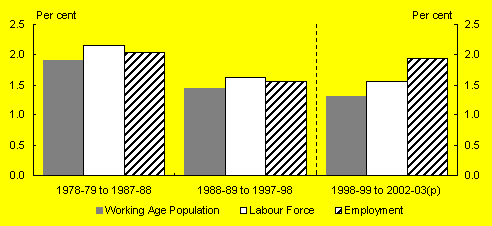The following is a reprint of Statement 3, Economic Policy Reform and Australia’s Recent Economic Performance, from Budget Paper No.1: Budget Strategy and Outlook 1999-2000.
Part I: Introduction
Since the onset of the East Asian economic and financial crisis in late 1997 the Australian economy has continued to record strong growth, despite many of Australia’s Asian major trading partners (MTPs) experiencing recession and a consequent slowdown in world economic growth.
Defining features of the Australian economy are a sound macroeconomic policy framework and greater efficiency and flexibility that have resulted from significant microeconomic reforms affecting product, capital and labour markets. This allowed the exchange rate to decline since late 1997 in an orderly fashion against the United States dollar and European currencies, while maintaining a stable and low interest rate environment that has helped to sustain domestic demand. In short, sound policies have underpinned the resilience of the economy in weathering the Asian downturn.
The decline in the exchange rate cushioned the effect of lower commodity prices and provided opportunities for commodity exporters to find alternative markets outside the recessed Asian economies. This has been assisted by the relative strength in the United States and European economies.
On the other hand, exports of elaborately transformed manufactures (ETMs) and services have been affected to a much larger extent — not only compared with the impact on commodity exports, but also with respect to previous periods of weak world growth in the early 1980s and early 1990s. This reflects the importance of Asian markets and the difficulty in finding alternative markets for these items in the short term. As regards Australia’s terms of trade, the decline has been relatively moderate compared with past episodes, with the effects of lower world commodity prices being partly offset by falls in world prices for many of our imports.
The Australian economy has been cushioned by the ongoing strength in domestic demand, supported by: lower short and long-term interest rates; strong productivity growth; sustainable wages growth; strong employment growth and falling unemployment; healthy corporate profits; and low inflation and inflationary expectations. This favourable combination is the outcome of a sound macroeconomic policy framework that has delivered sustained low inflation and sound public sector finances, coupled with an ongoing microeconomic reform agenda that has delivered higher productivity growth and a more responsive and flexible economy.
Part II: The Nature of the External Environment and the Economy’s Response
The current slowdown in world economic growth substantially reflects the deep recession in Japan and the crisis in a number of East Asian economies. Economic activity in Australia’s MTPs fell in 1998, with only weak growth expected in 1999 and a modest strengthening in 2000 (Charts 1 and 2). This contrasts with previous slowdowns in world growth in the early 1980s and the early 1990s when East Asian economies, and to a lesser extent Japan, remained relatively buoyant.
Chart 1: Australian and MTP GDP growth
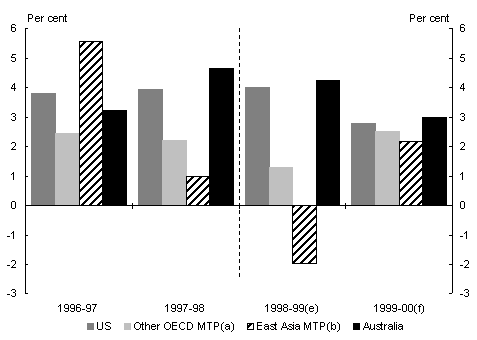
- Germany, France, the United Kingdom, Italy, Canada and New Zealand (weighted by merchandise exports).
- Japan, Korea, Singapore, Taiwan, Hong Kong, China, Indonesia, Malaysia, Thailand and the Philippines (weighted by merchandise exports).
Source: ABS Cat. No. 5206.0, various national statistical publications and Treasury.
The world economic downturn has contributed to a sharp 17 per cent fall in world prices of Australia’s commodity exports. Moreover, export volume growth has been affected more on this occasion than in the past. This is particularly the case for ETMs and services, for which East Asian economies are major markets and diversion to other markets is relatively difficult.
In contrast, the decline in the exchange rate since late 1997 and the ability of commodity exporters, in particular, to divert sales to more buoyant markets in the United States and Europe have cushioned the effects of the downturn to some extent. Furthermore, Australia’s terms of trade have been less affected than in the mid-1980s and early 1990s, with weakness in East Asia putting downward pressure on the world prices for some of Australia’s major imports, helping to offset weakness in world commodity prices. World interest rates have also been lower on average than during the early 1990s, and that has cushioned the slowdown in world growth during the period and has helped Australia maintain a low interest rate environment.
The nature of the external environment
Japan and the troubled East Asian economies (ie Korea, Indonesia, Malaysia and Thailand) are significant trading partners for Australia, accounting for around 39 per cent of total merchandise exports, including 44 per cent of commodity exports and 19 per cent of ETM exports, over the 1990s. As a result, the severe recessions in these economies contributed to negative MTP growth in 1998 and the prospect of growth well below trend in 1999 and 2000 (Chart 2).
Chart 2: MTP GDP growth(a)
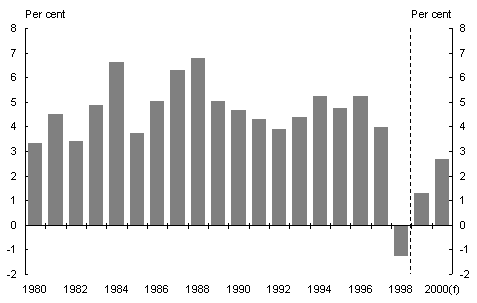
- Major trading partner growth weighted by merchandise exports share.
Source: Various national statistical publications and Treasury.
However, some of the effects of lower MTP growth have been avoided by commodity exporters diverting export sales from East Asian MTPs to other, more strongly growing, markets. For example, through the year to the September quarter 1998, the value of commodity exports (excluding gold) to the troubled East Asian economies fell by 11 per cent, while commodity exports to countries outside Asia rose by 18 per cent. While data are not readily available to calculate a price-volume split by country of destination, for commodity exports much of the relative change in values is likely to be attributable to changes in volumes.
Since late 1998 there has been some recovery in commodity exports to the troubled East Asian economies as these economies have begun to recover slowly. Commodity exports (excluding gold) to these economies rose by 18 per cent in the three months to March 1999 compared with a year earlier, while commodity exports to countries outside Asia fell by 1 per cent over this period as economic growth in other regions has moderated. Commodity exports to Japan have continued to weaken, as the Japanese economy remains recessed, falling by 8 per cent in the three months to March 1999 compared with a year earlier.
Much less diversion of exports of ETMs away from troubled East Asian markets seems to have occurred. For example, the value of ETM exports to these economies and Japan declined by 42 per cent in the first year of the crisis. The value of exports to countries outside Asia increased by 5 per cent, with ETM export values declining by 6 per cent in total.
The scope for Australian commodity exporters in particular to raise or lower sales in various markets in response to changing economic conditions means there is merit in considering a broader measure of international economic activity than MTP growth. One such measure is overall world GDP growth. Most of the recent slowdown in world growth is attributable to Japa
n, which accounts for around 15 per cent of world GDP. While the contractions in other East Asian economies have been particularly severe, the economies of Korea, Indonesia, Malaysia and Thailand constitute only around 3 per cent of world GDP. World growth has been buoyed by the strength in the United States and, to a lesser extent, Europe, which together account for a little more than half of world GDP. Hence, the slowdown in world growth has been less significant than the sharp downturn in Australia’s MTP growth (Chart 3).
Chart 3: World GDP growth
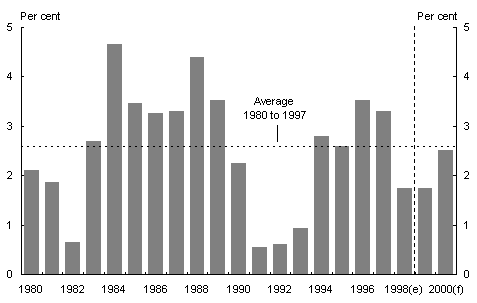
Source: Various national statistical publications, the IMF and Treasury.
One reason economic growth has remained strong in the United States and relatively firm in Europe over this period is the macroeconomic policy environment in these countries. When the slowdown in East Asia emerged in late 1997, interest rates were already at low levels in the United States and Europe. The maintenance of this policy framework has meant that interest rates have remained at relatively low levels throughout the current period of below-trend world growth. This contrasts with the experience of the early 1990s when interest rates in the industrialised economies were generally at very high levels, as world growth initially fell below trend, and were reduced only gradually over the next three years of below-trend growth.
The impact on export volumes
The concentration of slower growth in Australia’s East Asian MTPs has resulted in a sharp downturn in export volume growth. This has occurred despite the success of commodity exporters in diverting their product away from the troubled East Asian economies. ETM and service exports are more sensitive to changes in income in the importing country, with less scope for diversion to alternative markets than commodity exports.1 As a result, exports of ETMs have been most affected by severe recession in a number of East Asian economies. ETM exports fell by 6.6 per cent in 1998, compared with an average growth rate of 10.3 per cent since the early 1980s (Chart 4). This is a much more severe impact than was felt with the slowdown in world growth in the early 1980s or the early 1990s.
Service export volumes have continued to grow over the past year and a half, but at rates well below the longer-term trend. Volumes grew by 1.8 per cent in 1998, down from an average growth rate of 7.4 per cent since the early 1980s.
Despite significant diversion of commodity exports to markets outside East Asia, there was no growth in the volume of commodity exports in 1998. This compares with an average annual growth rate of 4.6 per cent over the past two decades. However, the relative weakness in commodity exports partly reflects the impact on farm production of the return to normal seasonal conditions in 1997-98, following very strong farm product growth in 1996-97, and so is not entirely attributable to the international downturn.
Overall, total export volumes fell by 0.5 per cent from the September quarter 1997 to the December quarter 1998. This compares with average annual export volume growth over the past two decades of 6 per cent and is a much sharper slowdown than that experienced in the mid-1980s and early 1990s (Chart 5). The very large fall in export volumes in the early 1980s was exacerbated by the fall in rural production due to the drought that affected much of Australia.
Chart 4: Annual growth in export volumes — Period averages
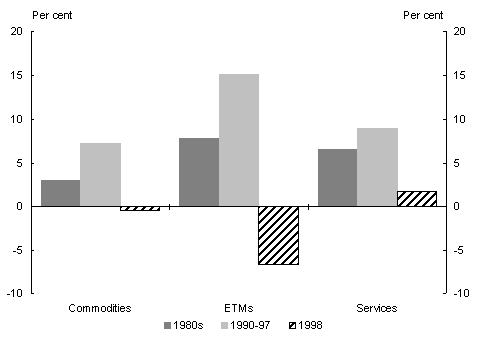
Source: ABS Cat. No. 5302.0.
Chart 5: Annual growth in the total export volumes
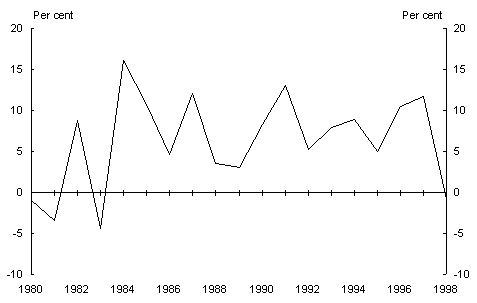
Source: ABS Cat. No. 5302.0.
The impact on the terms of trade
The weakness in export volumes contrasts with the relatively mild fall in Australia’s terms of trade. The terms of trade have fallen by 6.6 per cent since the September quarter 1997. This has been a more modest fall than those which occurred in the mid-1980s and early 1990s (Chart 6). While commodity prices on world markets have fallen sharply, exerting a negative influence on the terms of trade, this has been partly offset by falls in the prices of a range of other goods on world markets, including the prices of many items that Australia imports. The relatively mild fall in the terms of trade over this period is one factor helping to limit the impact of the international downturn on Australia.
In United States dollar ($US) terms, import prices across the docks have declined by nearly 10 per cent since mid-1997. For example, the prices of cars and computer equipment across the docks have fallen in $US terms by 6 per cent and 24 per cent respectively since September 1997. These two items account for around 20 per cent of Australia’s goods imports. In contrast, during the previous international downturn in the early 1990s, import prices in $US terms were relatively stable.
The recent falls in world prices of Australia’s imports reflect a combination of lower global production costs, resulting from falling commodity prices, technological advances and stronger productivity growth in a number of countries, a more competitive global trading environment, and very low inflation and inflationary expectations in most industrial economies. The downturn in East Asia is likely to have added considerably to the strength of competition in world markets for manufactured items, with domestic demand in East Asian economies very weak and Asian manufacturers benefiting from lower exchange rates.
Chart 6: Terms of trade
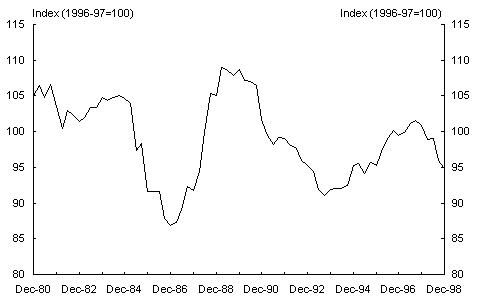
Source: ABS Cat. No. 5302.0.
A lower Australian dollar supports the export sector
The significant overall decline in the Australian dollar ($A) against major currencies since the onset of the Asian crisis has partly cushioned Australia’s commodity exporters from the effects of the sharp fall in world commodity prices. Between the September quarter 1997 and the March quarter 1999 commodity prices fell by 17 per cent in $US terms but fell only slightly in $A terms.2
While the $A and commodity prices tend to move broadly in the same direction, movements in the $A generally only provide a partial offset to changes in world commodity prices, particularly where changes in the overall terms of trade are relatively small.
On this occasion, the decline in the $A has probably reflected not only the decline in commodity prices and the terms of trade, but also the difficulties faced by exporters of ETMs and services in attempting to maintain export volumes in the face of the downturn in East Asia. The decline in the $A has helped all parts of Australia’s export sector to adjust to the international downturn.
The fact that the overall decline in the $A over this period did not result in significant inflationary pressures, and hence could be accommodated with both short and long-term interest rates trending down, owes much to Australia’s sound fiscal and monetary policy framework. This issue is discussed further below.
Part III: The Benefits of Policy Reform
Australi
a’s economic performance in the period since the emergence of the East Asian financial crisis has benefited from a robust policy framework, reflecting both improvements in macroeconomic policy settings in recent years, and structural reforms that have been implemented progressively over a longer period of time.
The macroeconomic policy framework
Australia’s economic performance in recent decades has been constrained by the tendency for inflation and current account pressures to emerge following even relatively brief periods of strong economic growth, and at a point where unemployment was still high. Policy has periodically allowed, or even contributed to, the emergence of excess demand pressures. Subsequent policy tightening to control rising inflation and current account deficits (CADs) has then contributed to short-term economic downturns. Policy has too often been reactive and short-term in its focus, and unclear in its objectives.
The forward-looking medium-term frameworks now in place for fiscal and monetary policy mean that each arm of policy is anchored by a clear primary objective that it is best suited to achieving: fiscal policy to ensuring adequate public saving; and monetary policy to maintaining low inflation. This strategy has two key facets.
First, it is directed at keeping the economy growing at a strong but sustainable rate that avoids excess demand pressures spilling over into inflation and the current account. This is essential to sustain expansions for longer and avoid the ‘boom-bust’ syndrome that has plagued the Australian economy, and contributed to a ratcheting up of unemployment over the past quarter-century.
Fiscal and monetary policies are now more likely to operate in a complementary fashion to limit, and not exacerbate, demand fluctuations. For example, the medium-term framework for fiscal policy implies that a loosening can be used to support the economy in the event of a downturn, but that the budget will need to be returned to surplus in the expansion phase of the cycle. This should assist the operation of monetary policy, as it is less likely that fiscal policy will contribute to excess demand pressures during the cyclical upswing.
A steadily growing economy that gradually approaches its capacity constraints can also help to lower the threshold at which inflation pressures start to emerge. In a steadily growing economy, firms are better placed to avoid short-run supply constraints because they are able to anticipate developments and plan ahead to expand capacity through investment and the hiring and training of new staff. This may make a modest contribution to lowering structural unemployment, as those who are unemployed are given more opportunity to gain skills and work experience that assist their future employability.
Second, policy is directed at raising the economy’s growth capacity over time; by reducing the rate of unemployment that can be sustained without increasing inflation, and by raising the growth rate that is sustainable once the economy reaches that point. Over the longer-term these are primarily the outcome of structural factors. Structural reform — which encompasses a wide range of policy, including taxation and labour market reform, competition policy, tariff reduction, and financial sector and corporate law reform — has been, and continues to be, the key to raising the economy’s productive potential. This is discussed below.
That said, macroeconomic policy can also play a role. Higher public saving should reduce the average CAD over time and lead to a more soundly-based CAD. This should reduce the risk that a cyclical increase in the CAD may trigger financial market concerns that limit the scope for growth. A credible macroeconomic policy framework provides greater certainty as to how policy will be conducted over time. Monetary policy credibility, through its effects on inflationary expectations, may of itself help to lower the unemployment rate at which inflationary pressures start to emerge.
Higher public saving and lower inflation can also contribute to raising potential economic growth through positive effects on national saving and investment. Low and stable inflation provides more certainty for long-term investment planning. High inflation tends to mask relative price signals and distort saving and investment decisions.
Monetary policy and inflation
Australia began the 1990s lacking a clearly articulated monetary policy framework and, despite a decline in inflation, retained a reputation as an ‘inflation-prone’ economy. Critics of Australia’s monetary policy approach saw the lack of a specific target anchor for monetary policy decisions, and a perception of limited Reserve Bank independence in setting monetary policy, as impediments to achieving sustained low inflation.
The Reserve Bank first indicated an informal objective for inflation in 1993. In August of 1996, a clear and transparent Statement on the Conduct of Monetary Policy was agreed between the Treasurer and the Reserve Bank Governor. It formalised the target of ‘keeping underlying inflation between 2 and 3 per cent, on average, over the cycle’.3 Importantly, the Statement formalised a clearer recognition of the independence of the Reserve Bank in conducting monetary policy. The Statement was important in first setting policy, then explaining it, and finally enhancing the credibility and responsibility for executing it.
Both inflation and inflationary expectations have declined sharply over the 1990s (Chart 7). Underlying inflation has averaged around 2 per cent per annum in the second half of the 1990s, compared with over 8 per cent in the 1980s. This success has been supported by favourable circumstances that have restrained global producer prices in recent years and the heightened competitive pressures engendered by product and labour market reforms. But clearly, the process has been anchored by wage and price-setters accepting the authorities’ commitment to the inflation target.
Chart 7: Australian inflation and inflationary expectations
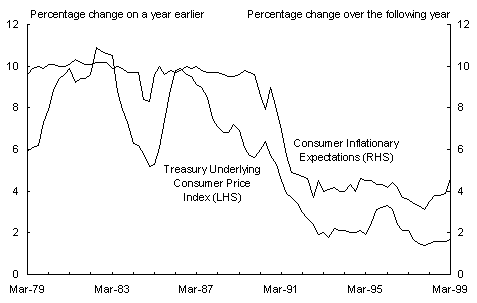
Source: ABS Cat. No. 6401.0 and Melbourne Institute of Applied Economic and Social Research, Survey of Consumer Inflationary Expectations.
Sustained low inflation allowed sharply lower nominal interest rates and has contributed to lower real interest rates in recent years. In periods of high and variable inflation, lenders tend to seek a premium to compensate them for uncertain future returns. As the credibility of Australia’s fiscal and monetary policy frameworks has been established with financial markets, long-term interest rates have fallen, both absolutely and relative to other economies (Chart 8). For example, the interest rate differential between Australian and United States 10-year Treasury bonds has averaged around 70 basis points over the past three years, compared with an average of around 350 basis points over the 1980s.
Monetary policy credibility means that firms and individuals expect that the Reserve Bank will act to maintain low and stable inflation, and are likely to factor this into their decision-making. This change in behaviour should, of itself, reduce the extent of interest rate increases needed over the course of the economic cycle to head off inflationary pressures.
Low and stable inflationary expectations also reduce the likelihood that domestic inflation will respond in a sustained way to transitory pressures. Consequently, there is less need for monetary policy to respond to such developments. The onset of the East Asian financial crisis in 1997 contributed to a significan
t depreciation of the Australian dollar, particularly against the currencies of the major economies. In the past, falls in the currency have flowed through into higher consumer price inflation. This time, a better policy framework and a more competitive economy have helped minimise the flow-on of import price rises into domestic prices and wages, as discussed in Statement 2.4 The recent Australian experience, in which short-term interest rates were reduced, contrasts with that of New Zealand and Canada, which had raised interest rates in the face of declining exchange rates.
Chart 8: Yields on Australian and United States 10-year Treasury bonds(a)
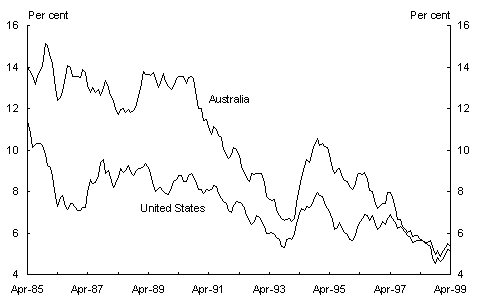
- Data are the average of daily yields in each month.
Source: Datastream.
Fiscal policy and public saving
In the mid-1990s, fiscal policy was at a critical juncture. In 1995-96, the fifth year of recovery, the underlying Commonwealth budget deficit still stood at 2 per cent of GDP. This followed a long period in which fiscal policy had generally been conducted without a clearly articulated and demonstrated medium-term framework. Over the period from 1975-76 to 1995-96 inclusive, the Commonwealth’s underlying budget deficit had averaged 1.4 per cent of GDP. Commonwealth general government net debt, which was non-existent in 1974-75, had increased to over 19 per cent of GDP in 1995-96.
The deterioration in the Commonwealth’s fiscal position from the mid-1970s has been associated with a structural increase in Australia’s CAD. The CAD averaged around 2 per cent of GDP over the 1960s and 1970s, but has averaged almost 4 per cent of GDP over the 1980s and 1990s. Against this background, a perception that governments lacked commitment to sound fiscal policy principles undoubtedly contributed to the interest rate differentials required to induce foreign lenders to hold Australian debt.
The Government moved quickly after its election in 1996 to develop fiscal credibility by adopting a medium-term objective of achieving underlying balance, on average, over the economic cycle. Credibility was also enhanced through a legislated Charter of Budget Honesty. The budget was returned to underlying surplus in 1997-98 and is projected to remain in surplus over the forward estimates period.5
As the Commonwealth general government sector is not projected to be drawing on private saving over the forward estimates period to fund its own activities, it is no longer directly contributing to the national saving-investment imbalance reflected in the CAD. This compares to an average Commonwealth saving-investment imbalance of around 1 per cent of GDP over the previous two decades. The general government sector will contribute to raising national saving and lowering the structural CAD over time, other factors equal.6
As discussed in Statement 1,7 sustained improvement in public saving can be expected to improve national saving over time. This improvement may also encourage greater private investment, through lower interest rates and confidence effects, but this is unlikely to offset on an ongoing basis the effect on the CAD of higher national saving. Notwithstanding this, increases in the CAD may occur during periods in which public saving is improving, as a result of other factors. For instance, in the late 1980s a cyclical boom boosted both investment (and, thereby, the CAD) and the budget surplus. In the absence of higher public saving, the CAD would otherwise have been even larger.
An improvement in public saving is helping to limit the recent rise in the CAD in response to the downturn in many of our East Asian export markets, and has been crucial to retaining the confidence of the financial markets. Importantly, the increase in the CAD on this occasion reflects private saving and investment decisions, rather than government borrowing.
Sound macroeconomic policy settings have allowed Australian interest rates to remain low, and this has contributed to subdued growth in the net income deficit. Australian financial corporations have taken advantage of the low world interest rate environment and the benefits of Australia’s more open and efficient financial markets to access opportunities in global markets to lower financing costs. Continued low world interest rates and an increasingly open financial sector are expected to continue to support this over the medium term.
In addition, compared to earlier periods, there has been a change in the make-up of Australia’s external assets and liabilities. Australian external liabilities denominated in foreign currencies are now more than offset by external assets denominated in foreign currencies. Thus the depreciation of the Australian dollar since the onset of the economic downturn in East Asia has had a broadly neutral impact on the net income deficit. This compares to previous periods when Australia’s external liabilities denominated in foreign currencies clearly exceeded assets and thus net payments in Australian dollar terms escalated when the Australian dollar depreciated.
Structural reform, productivity and economic efficiency
Structural reform is concerned with improving economic efficiency by making the economy more competitive and more dynamic and by removing distortions that misallocate resources.8 Effective competition in markets for goods and services provides greater impetus for firms to seek productivity improvements and ensures that more of these gains are distributed in the form of lower prices rather than higher profits. Competition also provides a spur to innovation. By increasing the supply potential of the economy, structural reform allows the economy to grow further before inflationary pressures arise. Ultimately, this allows stronger sustainable growth in incomes and employment.
Structural reform (including labour market reform) is likely to have contributed to the economy’s recent resilience in a number of ways.
- Underlying the economy’s recent growth performance is an upturn in multifactor productivity growth (Chart 9) in recent years that has reversed the decline that occurred during the 1970s and 1980s.
- As outlined previously, the fact that the economy is now subject to markedly increased competitive pressures has helped to maintain low inflation in the face of a large currency depreciation.
- Structural reform has also resulted in a more flexible and outward-looking business sector and this has contributed to the ability of Australian firms to take advantage of the real exchange rate depreciation.
- By improving the quality of investment decisions throughout the economy, structural reform is likely to have contributed to the willingness of financial markets to accept a private sector-induced expansion in the CAD.
Productivity is difficult to measure and is affected by a range of factors not directly attributable to structural reforms. For instance, advances in information and other technologies may be contributing to an upturn in productivity growth globally. However, the extent of structural reforms that have been instituted over the past decade or so, and the productivity gains that have occurred in sectors that have been a specific focus of reform — particularly sectors that were formerly dominated by publicly-owned monopolies — suggest that such reforms have been a significant factor.
Chart 9: Multifactor productivity growth in the market sector(a)
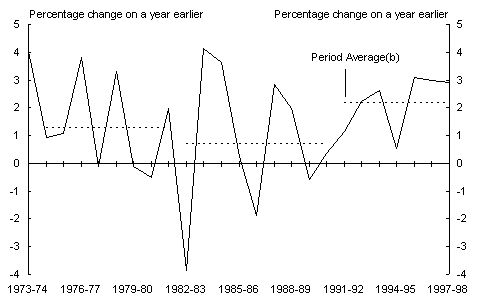
- Multifactor productivity growth accounts for output increases beyond those explained by increases in capital and labour inputs. The estimates of multifactor productivity assume constant returns to scale; and are subject to errors in the measurement of labour inputs, the capital stock and their respective output elasticities.
- Dotted lines are average multifactor productivity growth rates for business cycle periods, measured from the year following each cyclical trough year to the next trough year (to 1997-98 for the current expansion).
Source: ABS Cat. No. 5204.0.
Earlier reforms substantially reduced barriers to external trade, and more recent reforms are increasing competitive disciplines in the non-tradables sector. An important element of structural reform in recent years has been the National Competition Policy, which was agreed to by all Australian Governments in April 1995. This includes a nationally applied competition law and requirements to ensure that government businesses and privatised public monopolies do not enjoy an unfair advantage over competitors. Governments are also required to review anti-competitive legislation, which must be reformed unless there are net benefits that can only be achieved by restricting competition.
A key objective has been to increase competition in sectors where it has been limited by regulatory barriers, particularly in the communications, energy and transportation sectors. A fully open market for telecommunications was introduced in 1997, a National Electricity Market allowing electricity to be freely traded between the eastern mainland States has recently commenced, and regimes are being developed to allow private operators access to natural gas pipelines and rail infrastructure.
The full benefits from more recent reforms, including labour market reforms, are yet to be seen, and this is likely to provide a continued boost to productivity growth over the next few years. The potential for further productivity gains in sectors like telecommunications and electricity is likely to be significant. Moreover, the dynamic effects of reform, in terms of providing a continuing impetus to innovation and productivity improvement, should have an ongoing positive effect on productivity growth.
Labour market reform
Reforms to workplace relations arrangements and labour market regulation and assistance have sought to increase the responsiveness of the labour market to changes in the economy, and reduce impediments to job creation, participation in employment and improving productivity.
Significant reforms to workplace relations have been implemented, including encouragement for direct enterprise bargaining, freedom of association and tighter limits on industrial action. The introduction of the Workplace Relations Act 1996 has accelerated the move from centralised wage fixing to enterprise bargaining — ensuring that wages and workplace practices are consistent with the circumstances faced by individual firms — while providing a genuine safety net for low paid workers.
Policies have been implemented to assist and encourage job search by unemployed people, including the new Job Network, changes to activity tests, and tighter eligibility conditions for a range of benefits. Other initiatives are directed at improving workforce skills and abilities in order to improve the employment prospects of unemployed people and to enhance long-run productivity growth.
Labour market reform has contributed to the upturn in productivity growth discussed above. Importantly, the recent period of strong economic growth has not been associated with the emergence of unsustainable wage pressures that have contributed to increasing inflation in past periods when the economy has grown strongly at an advanced stage of the expansion. This is likely to be attributable in no small part to workplace relations reforms.
Financial market and corporate law reforms
The crisis in East Asia emphasises the importance of sound corporate governance and prudential supervision, and these issues are at the forefront of international efforts to reduce the risk of similar crises occurring in the future. The soundness of Australia’s arrangements is a key ingredient in its ability to maintain a high level of business and investor confidence.
The stability, integrity and efficiency of the financial sector are critical to the performance of the economy and its ability to adapt to changing circumstances. Deregulation in the 1980s substantially increased competition and innovation in the financial sector, resulting in improved access to capital markets, a greater range of financial products and better allocation of savings to investment. It also highlighted weaknesses in the operations of markets and the need for comprehensive prudential regulation. The major package of reforms implemented following the Wallis Inquiry build on these foundations by reducing artificial barriers to competition between different types of financial service provider.
The recent reforms also establish a more flexible regulatory system, with a functional rather than institutional focus, that is better able to respond to a rapidly changing environment without stifling innovation and competition. This will meet the need for regulation to ensure stability and integrity, without endangering efficiency.
In addition, the Corporate Law Economic Reform Program is modernising and giving an economic focus to regulatory requirements regarding fundraising, takeovers, corporate governance, financial reporting and conduct and disclosure practices in financial markets. Again, the focus is on providing the regulation necessary for well-functioning markets, without compromising efficiency.
Part IV: The challenge Ahead
The economy’s growth potential
Sound macroeconomic policy and sustained structural reform represent major steps toward addressing inflation and current account problems. The full benefits of more recent reforms have not yet been seen, which raises the question of how fast the economy can grow sustainably over the medium term.
As noted in Statement 1, for the purposes of Budget figuring, real GDP growth of 3 per cent is assumed in the forward estimate years from 2000-01 to 2002-03. This is not a forecast, nor is it an estimate of ‘potential’ growth. Rather, it is a projection based on historical averages and broad underlying trends.
The prospect of continuing strong productivity and employment growth, flowing from the reform processes discussed above, suggests that real GDP has the potential to grow at a rate above 3 per cent on average over the medium term, provided the macroeconomic policy framework is sustained.
As noted above, market sector multifactor productivity in the 1990s expansion has so far averaged around 2 per cent per annum, well above the average of the 1980s growth cycle of around per cent per annum. Similarly, growth in average labour productivity (GDP per employee) has thus far averaged above 2 per cent per annum in the 1990s expansion, up from around 1 per cent per annum in the 1980s growth cycle. Average labour productivity growth was very rapid at around 3 per cent in 1997-98, but is estimated to moderate to around 2 per cent in 1998-99. The forecasts for 1999-2000 incorporate a cyclical slowing in average labour productivity growth to around 1 per cent. On these estimates, the growth rate of average labour productivity between 1997-98 and 1999-2000 would be around 2 per cent per annum, close to the average for the 1990s as a whole, despite the recent international downturn. The strong productivity performance during this recent period has helped the e
conomy to withstand the international downturn by supporting growth in real household incomes and profits and by contributing to low inflation.
Looking ahead to the early years of the next decade, there are several factors likely to influence the productivity outlook. A significant factor behind the rapid growth in productivity in the 1990s has been the ongoing programme of microeconomic reforms, including reforms to the labour market. It seems likely that some of the benefits of more recent reforms, such as the Workplace Relations Act 1996 and the application of the mutual obligation principle, have yet to be felt and will influence outcomes during the early years of the next decade, although these effects are difficult to quantify. Outcomes will also be influenced, of course, by future microeconomic reforms, further reforms in the labour market, and the new taxation system.
It is also likely that part of the strong labour productivity growth in the 1990s expansion reflects significant growth in the capital/labour ratio through the 1990s, compared with a relatively constant ratio over the 1980s cycle. However, as outlined in Statement 2, business investment growth is expected to moderate in 1998-99 and 1999-2000 after six years of very strong growth. If business investment were to be around its long-term average share of GDP in the early years of the next decade (see Chart 5 in Statement 2), then the capital/labour ratio would be likely to grow at around its long-term trend. This, in turn, would point to some slight moderation in average labour productivity growth, other factors unchanged.
On balance, given the microeconomic reforms already in place and current levels of investment, average labour productivity growth of between 1 and 2 per cent would seem to be sustainable over the early years of the next decade.
The other key element in sustaining a relatively high rate of economic growth over the medium term is strong employment growth. The potential, or sustainable, rate of employment growth depends upon labour force growth and also the structural rate of unemployment. Neither of these factors is constraining present employment growth, but both could come into play in the period ahead.
The current unemployment rate is above most estimates of the structural rate of unemployment. For example, the OECD noted that most estimates of the structural rate of unemployment in Australia are in the 6 to 7 per cent range for the mid-1990s.9 However, such estimates generally do not include an allowance for the likely beneficial effects on structural unemployment of recent reforms to product and labour markets. As noted above, these benefits are likely to be still accruing. Nor do such estimates make any allowance for future reforms in the labour market. More fundamentally, they do not acknowledge that structural unemployment may have a dynamic element, such that the rate will fall as actual unemployment falls. This appears to have been part of the recent United States experience.
In short, there is scope for the unemployment rate to fall significantly below its present level of around 7 per cent (and hence for employment growth to outstrip labour force growth) over the medium term without igniting inflationary pressures. The extent of these further falls in unemployment depend, in part, on the extent of further labour market reform, taxation reform, social security reform, and microeconomic reform more generally.
That said, a factor influencing likely employment growth over the medium term is lower projected labour force growth than in recent decades, due to demographic effects (see Box 1). Labour force growth could be around 1 per cent per annum in the medium term, lower than the average growth of recent decades. This reflects expected lower growth in the working age population and only a relatively small net increase in the participation rate in the medium term.
| Box 1: Demographic influences on medium-term labour force growth
Labour force growth is expected to be lower over the medium term than the average of recent decades, as a result of lower projected growth in the working age population and relatively moderate growth in the total participation rate. While average working age population growth over recent decades was around 1 per cent per annum, it is expected to fall to around 1 per cent per annum in the medium term. The total participation rate has risen steadily in recent decades, but only a modest increase from its average level in 1998-99 is likely in the medium term. As participation rates vary markedly between different age groups, changes in the age-structure of the working age population can influence the total participation rate. The ageing of the population (in isolation) has placed downward pressure on the total participation rate in recent decades. This is expected to continue to be the case, possibly at an increased rate, over the medium term. This issue was discussed in more detail in the Summer 1999 Economic Roundup. Against this trend, increased employment opportunities over the medium term are expected to encourage some discouraged workers to re-join the labour force, resulting in continued increases in female participation rates (within age groups) and a flattening of the decline in male participation rates (within age groups). On balance, it is expected that, with slower working age population growth and a small net increase in the participation rate (relative to recent levels), labour force growth could be around 1 per cent per annum in the early years of the next decade (Chart 10). This would be somewhat lower than the average labour force growth over the 1980s and marginally lower than in the 1990s to date. It would also mean, of course, that the rate of employment growth needed to reduce unemployment would be lower than has been the conventional wisdom over recent decades. Chart 10: Employment, labour force and working age population growth — Period averages
|
On balance, given the demographic influences on medium-term labour force growth, employment growth of around 2 per cent per annum would seem to be achievable on average in the early years of the next decade, associated with further falls in the unemployment rate. Together with average labour productivity growth of 1 to 2 per cent per annum, this implies that the Australian economy has the potential to sustain growth of 3 to 4 per cent over that period.
Policy priorities in the period ahead
Achieving sustained growth in output and employment in line with the economy’s growth potential will require ongoing attention to the macroeconomic policy framework and continued microeconomic reform, including taxation reform and examination of the remaining rigidities that inhibit improved labour market outcomes.
Macroeconomic policy
It is important that macroeconomic policy maintain a consistent forward-looking focus on medium-term objectives. Policy credibility is won by discipline over many years, but the gains can be put at risk by relatively short periods of neglect. Policy should aim to maximise growth, subject to maintaining the medium-term inflation and fiscal balance objectives. This entails keeping the economy operating within sustainable bounds, so that excess demand pressures that might spill over into inflation and the cur
rent account do not emerge.
Fiscal policy will continue to focus on medium-term public saving objectives. The medium-term fiscal strategy is essential if the private sector is to continue to be able to tap into foreign saving to fund a substantial part of its investment without having to pay significant risk premia.
The fiscal strategy will ensure that the CAD over time is essentially the outcome of decisions by private sector borrowers and lenders, and not of government borrowing (one role of structural policies is to ensure that these private sector decisions are soundly based). The general government sector presently holds only 15 per cent of Australia’s net external debt. Private sector saving and investment decisions are now better based than they have been in past cycles, as a result of microeconomic reform and low inflation. In this environment the nation’s ability to service external debt should not be at issue.
The fiscal strategy must continue to take account of the economic cycle. Adequate surpluses will be required while the economy is expanding to allow room for policy to respond in the event of a downturn, at least to the extent of allowing automatic reductions in the surplus, from lower tax receipts and higher unemployment assistance payments, to support demand.
Monetary policy must continue to focus on the objective of achieving 2 to 3 per cent inflation on average over the medium term. Inflation has been persistently below the bottom of the band over the past two years, and the outlook is for continued low inflation in the period ahead.
Taxation reform
The existing taxation system is a significant impediment to improving Australia’s economic potential.
The tax reform package currently before Parliament includes changes to personal income tax rates and family and social security payments that will significantly lower effective marginal income tax rates, and improve incentives to work and save. Introduction of a broad-based Goods and Services Tax (GST), to replace the present Wholesale Sales Tax (WST) and a range of inefficient State taxes, will result in an indirect tax system that has lower costs, is less distorting to consumer decisions, and avoids taxing business inputs. The new tax system will lift the tax burden imposed by the WST on Australian exports, and reduce business costs, including costs of investment goods.
Similarly, the current Review of Business Taxation is directed at achieving a business tax system that minimises distortions to business decisions and reduces compliance costs, as well as providing a competitive regime for attracting international capital.
These reforms will contribute to raising the economy’s growth potential through more efficient resource allocation, as decisions throughout the economy better reflect underlying costs and benefits, and better incentives.
Taxation reform will also contribute to maintaining sound public finances. The narrowly-based WST is levied on a portion of economic activity that is declining over time as the relative importance of services in the economy increases. Revenue from the GST, which is to be allocated to the States, will grow in line with the economy. This will provide a revenue base that is capable of meeting spending needs over the medium to long term, without requiring periodic increases in taxation rates.
Labour market reform
Reducing unemployment in a sustained way will require a continuing focus on integrating sound macroeconomic policies and workplace relations reform with policies to ensure that the welfare system, and its interaction with the tax system, does not discourage people from seeking jobs.
Further reforms to the industrial relations system are being pursued to build upon those already implemented. Amendments to the current unfair dismissal laws and the preservation and extension of age-based junior wage rates are policies designed to overcome restrictions on employment growth. Other policies being pursued to enhance productivity and streamline enterprise bargaining include further award simplification, reducing the role of third parties in the agreement-making process and ensuring that union membership is voluntary.
Securing better labour market outcomes, particularly ongoing reductions in structural unemployment, will require an ongoing focus on the link between productivity and wages. One facet of this is ensuring that the award system fulfils its role of providing a genuine safety net.
The Government’s tax reform package will significantly reduce disincentives to work, which particularly affect low and middle-income earners. The principle of mutual obligation for unemployment beneficiary recipients is also important in ensuring that the welfare system does not discourage job seeking. The Budget extends the scope of mutual obligation arrangements and broadens the Work for the Dole scheme.
Attention to the education and training system is also important to ensure that the skills of the workforce are appropriate for the future demands of the economy. The Budget provides additional funding for education and training, including continued funding for programmes to enhance the skills and experience of young people seeking work.
It is important that the various elements of the labour market strategy are not considered in isolation. Recent international research demonstrates that labour market policies are complementary, and that broad, integrated reforms are more effective in achieving lower unemployment and sustainable improvements in productivity growth.
Part V: Conclusion
The recent performance of the Australian economy would not have been possible in the absence of a sound domestic policy framework. The institution of sound and credible frameworks for monetary and fiscal policies in recent years, and the return of the Budget to surplus, have been fundamentally important. Reforms in the areas of competition policy, the labour market, the financial sector and corporate law have also contributed to creating an economy that is more efficient and flexible, subject to more competitive pressures and more conducive to productivity growth.
Sound policy has been assisted by the fact that the downturns affecting our East Asian trading partners have occurred against a background of other international developments that have been favourable. World growth has been supported by the strength of the United States and European economies, together accounting for a little more than half of world GDP. In addition, the fall in our terms of trade from lower commodity prices has been limited by an international environment that has been reducing the world prices of Australia’s imports.
In this environment, the economy has been assisted by a large currency depreciation that has given Australian producers a competitive boost that has assisted export diversion to other markets. Large currency depreciations, however, cannot be effective unless sustained as real depreciations, a demanding policy requirement.
The favourable combination of exchange rate depreciation and continued low interest rates made possible by sound macroeconomic policy has been the key. Financial markets have retained confidence in Australia’s economic fundamentals, and long-term interest rate differentials have remained low. As the exchange rate depreciation has not been dissipated in higher domestic inflation, the economy has been able to enjoy the benefits of improved competitiveness, while maintaining relatively low interest rates; and the negative effects of international developments have been cushioned by ongoing strength in domestic demand.
As a result of sound macroeconomic policy and structural reforms, the Australian economy should be able to continue to grow strongly over the medium term and to achieve further sustainable reductions in unemployment. The extent to which the economy can grow and unemployment can be reduced will depend on cont
inued adherence to sound macroeconomic policy and further microeconomic reform — including, in particular, reform of the taxation system and further action to improve the functioning of the labour market.
1 See discussion in 1998-99 Budget Paper No. 1, Statement 2.
2 However, this does not include the impact of the large reductions in prices of bulk ores (coal and iron ore) sold under contract to Japan, that came into effect on 1 April 1999. The renegotiation of the contracts resulted in price falls in $US terms in excess of 10 per cent compared with the previous year.
3 Following changes to the measurement of the Consumer Price Index (CPI), notably to remove the effect of mortgage interest rate changes, the Bank has recently changed to targeting CPI inflaction.
4 Statement 2 of Budget Paper No. 1: Budget Strategy and Economic Outlook 1999-2000. Statement 2, Economic Outlook, is reproduced in this edition of the Roundup.
5 Surplus was achieved in 1997-98 in terms of the former cash underlying balance measure that was targeted by Government policy at the time.
6 A detailed discussion of structural improvements in the CAD is contained in 1998-99 Budget Paper No. 1, Statement 3.
7 Statement 1 of Budget Paper No. 1: Budget Strategy and Economic Outlook 1999-2000.
8 A detailed discussion of structural reform and its benefits is contained in 1997-98 Budget Paper No. 1, Statement 3.
9 OECD Economic Surveys, 1998-99, Australia.
